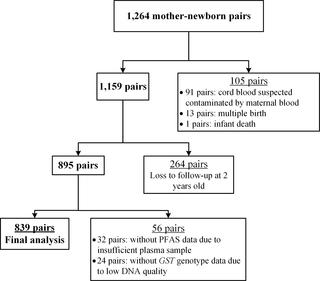PLOS ONE ( IF 2.9 ) Pub Date : 2019-01-16 , DOI: 10.1371/journal.pone.0210708 Hui-Ju Wen , Shu-Li Wang , Pau-Chung Chen , Yue Leon Guo

|
Background
Perfluoroalkyl substance (PFAS) exposure was found associated with atopic diseases. Atopic dermatitis (AD) is a childhood skin disorder. However, the effect of interaction between PFASs and glutathione S-transferase (GST) T1/M1 genotype on AD remains unclear.
Objective
To investigate the association between gene-environmental interaction and childhood AD using a birth cohort study.
Methods
From 2001 to 2005, 1,264 mother–newborn pairs were recruited from eight Taiwanese maternity hospitals. PFAS levels and Genotypes were analysed from cord blood. Information on children’s health status including AD occurrence was obtained via phone interviews at 6 months and 2 years. Cord plasma concentrations of nine PFASs were measured via ultra-high performance liquid chromatography/tandem mass spectrometry. GSTT1/M1 was genotyped (null/present) via polymerase chain reaction. Environment-gene interaction effects on AD were assessed using multiple logistic regression analysis.
Results
Overall, 839 mother–newborn pairs completed all measurements. The prevalence of ever having physician-diagnosed AD by 2 years of age was 5.4%. Among PFASs, perfluorooctanoic acid (PFOA) was positively associated with AD adjusted for potential confounders. After grouping PFOA levels into three groups: undetected, below and above the median in those with detected, children in above the median group who had the GSTT1-null, or GSTM1-null genotype exhibited a higher odds ratio for AD (OR [95%CI] = 3.45 [1.26–9.99] and 2.92 [1.12–7.91], respectively) as compared to the undetected group.
Conclusions
Our data demonstrated that in-utero PFOA exposure with GSTT1/M1 null genotype were associated with AD. Minimizing early-life PFAS exposure may help against AD development, especially in genetically susceptible individuals.











































 京公网安备 11010802027423号
京公网安备 11010802027423号